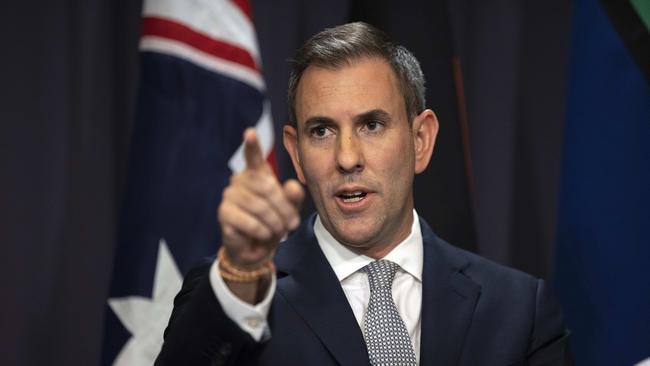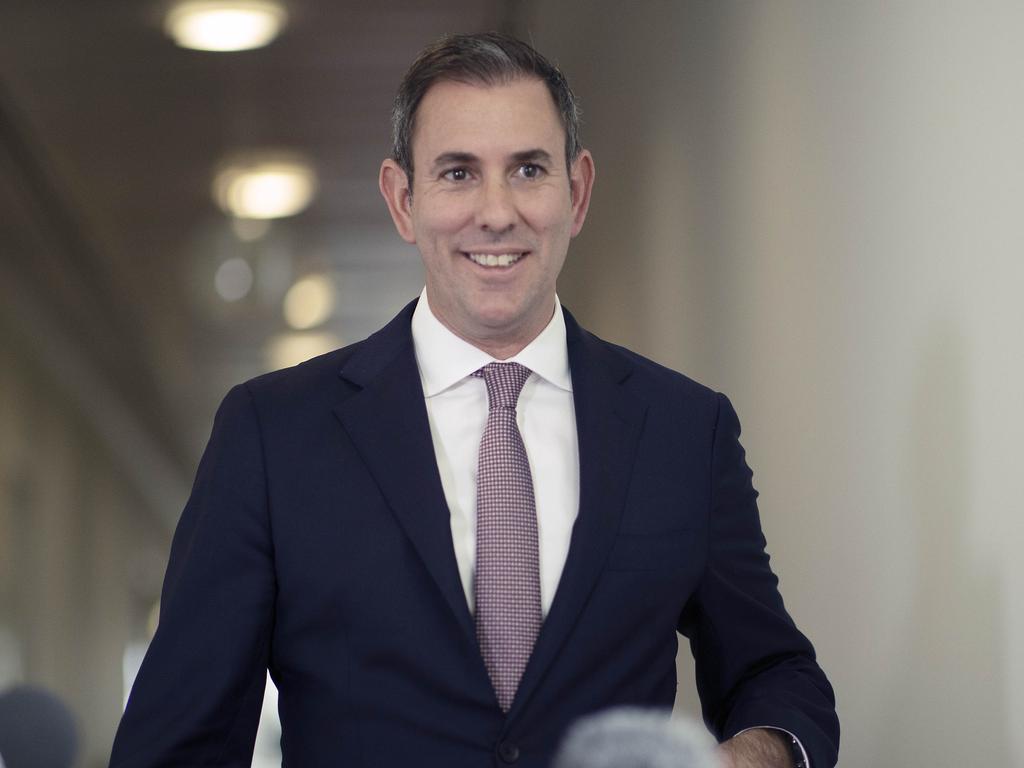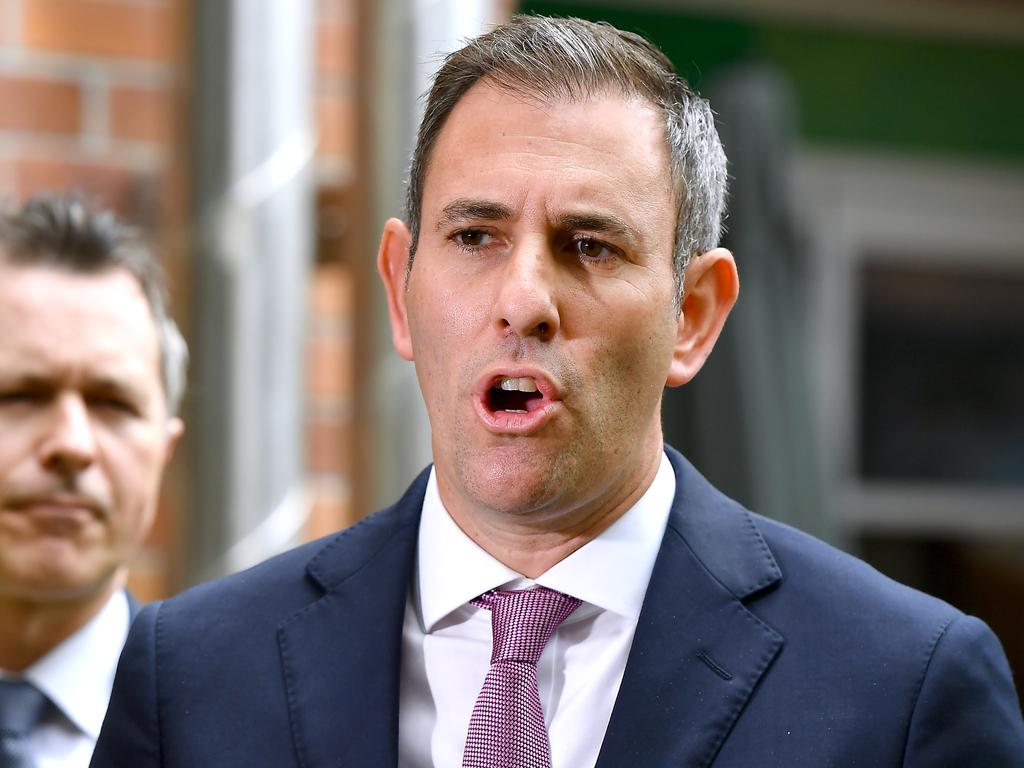Step right up for the greatest mini-budget show on earth
Given the ambitions of coming men there’s bound to be at least one dance move to wow the nation in Treasurer Jim Chalmers’ first budget.

Predecessors boasted of “bringing home the bacon” and a budget “back in the black”. In 2004, the custodian urged families “to have one for mum, one for dad and one for the country”, and so we had a “Costello baby boom” with a 20 per cent step-up in the number of school-leavers in coming years.
Chalmers worked for the man who claimed “the four surpluses I announce tonight”; a decade later, Swanny’s still got the porch light on. His protege starts from a solid foundation: an underlying deficit this year in the $35bn to $40bn range, or about half what Josh Frydenberg announced in his pre-election fiscal pitch in late March.
The 2022-23 budget 2.0 is really a mini-budget or bulked-up mid-year update, and the Treasurer was right to describe it as a “bread and butter” instalment. It will provide targeted relief to households, fund Anthony Albanese’s election promises and make noise about how Labor is “de-Morrisoning” lasting claims on the budget.
Chalmers will argue Labor’s spending is economically sound, not political. He believes it should be seen as investment in the supply side to ease inflationary pressures and promote productivity.
He’s making sure the Reserve Bank, which this week raised its cash-rate target for the sixth time, remains in the frame for inflicting pain on borrowers. The promise of more rate rises by RBA governor Philip Lowe ensures he’ll be seen as the Christmas grinch.
The Treasurer points to UK events – an example of discord when the central bank calls a slow waltz and the Tory leadership orders the quickstep. “Here at home, we must be careful not to misalign fiscal and monetary policy,” Chalmers said on Friday.
The perilous world economy will cramp Labor’s style. Treasury is scaling back its global growth forecasts for this year and the next two, implying output will be $US2 trillion ($3 trillion) smaller at the end of 2024 than previously expected. Those “storm clouds”, in Chalmers words, will take the shine off our export earnings, the main reason behind the $50bn improvement (over three months) in last financial year’s cash balance.
The Treasurer nominates two other constraints, or “pieces of context” for the budget. One is Lowe’s high-inflation “scourge”, which is eating into purchasing power, and the aggressive “whatever it takes” policy to get consumer price growth back to the RBA’s 2 to 3 per cent mandate, hopefully by the end of next year or 2024.
The other, more important, factor for long-term economic health Chalmers labels “persistent structural pressures on the budget”. Let’s call it out as Australian fiscal exceptionalism: the belief we can have it all and bugger the cost.
The Treasurer routinely highlights the “big five” spending pressures: debt servicing costs, aged care, disability care, hospitals and defence. “All spending that is either desirable or unavoidable or both – and must be paid for,” Chalmers said of these “constant and compounding” items in a speech in Brisbane on Friday.
We’ve expanded the reach of the state in the pandemic era – nudged along by royal commissions, population ageing and strategic threat reassessment – but haven’t come to grips with a way to fund a plus-sized Canberra. In his testimony to parliament three weeks ago, Lowe said Australia could not keep using the “national credit card” to pay for unsustainable spending commitments.
“We want really high-quality aged care, great education, world-class disability care, fantastic national defence, great infrastructure,” he told the house economics committee.
“What we haven’t worked out as a community is how to pay for it, and this is why we’ve got these budget deficits despite full employment and the record terms of trade.”
The standard view is that we can do one of three things to pay for these community wants: raise taxes, cut spending or grow the economy to get a bigger pie. None of these is pain free. In fact, we’ve been failing in pretty insipid ways on all three fronts for two decades.
“Taxes, cutting back and structural reform – we have to do one of those three things, maybe all three of them, if we’re going to pay for the goods and services that the community wants from our governments,” Lowe said.
“I would hope during this term of parliament that you could start addressing probably each of those three things.”
Treasury secretary Steven Kennedy has detailed this step-change in federal spending. Over the decade ahead, payments as a share of gross domestic product are expected to average 26.4 per cent, compared with the 24.8 per cent average from the 1970s to before the pandemic. In today’s dollars, that rise is worth $37bn.
Labor says it is hunting down Coalition “waste and rorts”, but this won’t make much of a dent in outlays. In a speech to Australian Business Economists in June, Kennedy noted the vast majority of spending was subject to legislation, existing commitments, or contracts, and the remainder supported government priorities.
“It takes time to build support for changes to programs and, given this, ensuring effectiveness of spending for any new programs will be critical,” Kennedy said.
The other way of funding these priorities, the Treasury chief said, was by raising additional tax revenues. That larger size of government, he added, needed to be balanced against associated costs such as disincentives to work or investment. “The effects of a larger tax take can be minimised by ensuring the design of the tax system is optimal,” he said.
We’re a long way from optimal, given the rising tax burden on young wage and salary earners, and bracket creep. Reviewing the tax base, making sure leaks are plugged and wealthy retirees paying a fair share are all pressing issues given the pressure to raise more revenue. As eminent economist Ross Garnaut said recently: “We have to stop kidding ourselves about the budget.”
It’s impossible to recall any mention of higher taxes by anyone during the election campaign or in the preceding three years. Chalmers is boxed in by history and politics, although he vowed this week to transcend them.
“My job and the government’s job is to take the right decision, even if it’s difficult, to put the economics before the politics and let the political cards fall where they may,” he told reporters on Wednesday.
The debate about the stage three tax cuts may be opportunistic, sly perhaps, possibly unhelpful to Labor right now, but it’s necessary. Even with the changes from July 2024, in a decade the average personal income tax rate reaches a record 26.7 per cent, higher than before the introduction of the GST in 2000 that was accompanied by tax cuts.
The tax cuts are hefty at almost $18bn in the first year, aimed at the highest earners (and therefore the people who pay the bulk of income tax), and will double in size due to wage inflation by the end of the decade. In any case, if the tax brackets aren’t indexed, so-called fiscal drag alone will be stealing close to another $60bn a year from workers by then.
On Friday, Chalmers flagged the third global slowdown in 15 years, after the global financial crisis’s “demand shock” and Covid-19 health crisis that became a “supply shock”. He said the coming trouble was an inflationary shock with a “hard landing” from aggressive monetary policy; the budget policy response would be “more targeted, more measured and more supply-side focused, so it isn’t counter-productive”.
We’ll need to rebuild fiscal buffers. Chalmers says Labor’s position on the legislated tax cuts has not changed. Perhaps, after all the verbal conjuring and backgrounding, that’s the rabbit in his hat.
In two years the economy may be in a woozy state as mortgage-cost pain slows consumer spending and growth creeps along next year at a rate of 1-point something. A bit of fiscal sugar in 2024, ahead of an election, might even pass the “responsible and affordable” test, and come with a signature Old Labor soft-shoe shuffle.








Jim Chalmers insists his first budget won’t be “fancy” or a “vanity exercise”, but given the ambitions of coming men there’s bound to be at least one dance move to wow the nation. Treasurers, after all, are politicians and can’t resist the music and lights, the rabbits and hats, of the fiscal fest.